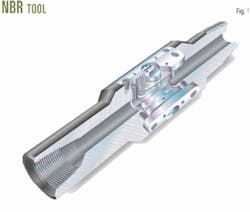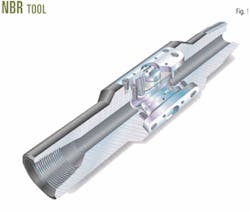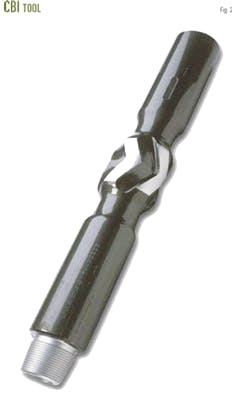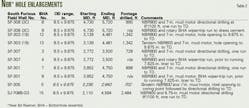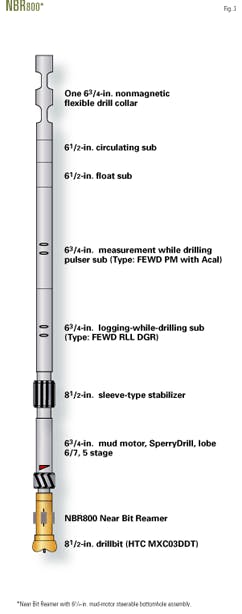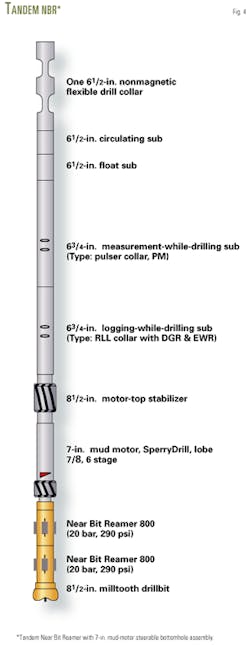Following repeated failure of bicenter drillbits to meet demanding requirements in a number of offshore East Malaysia wells, Royal Dutch/Shell Group's Shell Malaysia Ltd. drilled six wells with an alternate, steerable, hole-enlargement technology.
The company ran tools, known as the "Near Bit Reamer" (NBR), in a variety of bottomhole assembly (BHA) configurations. Engineers also ran, within the drillstring, a tool called the "Cuttings Bed Impeller" (CBI) to facilitate hole cleaning and maintain hole quality.
The technology enabled crews to drill out the cement shoe and enlarge the wellbore in a single run, saving multiple trips for reaming. The BHAs drilled uniform gauge and clean boreholes that minimized spiraling and allowed crews to run casing strings easily.
Drilling objectives
Shell Malaysia's objective, for the offshore South Furious field wells, was to drill out 9 5/8-in. casing-shoe track and the deviated hole to the section TD in a single bit run.
The company planned drilling operations, which called for use of an 8 1/2-in. bit to drill ahead, with the NBR tool concurrently to open the borehole to 9 7/8-in. diameter for installation of oversized 7 5/8-in. liners.
The company would use the oversized 7 5/8-in. liners, known as "Smart" completions, for special hardware to allow selective production from within a well by zone.
Planned wellbore trajectories would have a 3D profile, requiring controlled dogleg severity ranging 3°-8°/100 ft. Minimizing borehole spiraling and optimizing hole cleaning were well objectives to enhance completion operations.
Bicenter-bit trials
The company evaluated bicenter-drillbit technology for drilling an oversized hole below the 7-in. liner and to test whether a bicenter bit would drill faster or better than conventional drillbits. The bit suffered from formation-clay balling and penetration rates dropped to less than 5 fph.
In a second test, to drill a borehole to set 13 3/8-in. casing below the 16-in. liner, the company used a bicenter bit to drill 14 1/2-in. by 17 1/2-in. hole.
In this instance, however, the driller could not control the tool face, which presented high risk of collision in platform drilling. In addition, after encountering stringers, the reamer blade had completely worn-out leading to downhole tool failure.
In sliding mode or drilling with the mud motor without drillstring rotation, the 14 1/2-in. by 17 1/2-in. bicenter bit lasted only 500 ft until it began to hang up. Once the reamer blade had worn, it became virtually impossible to slide.
In order to achieve even a 2°/100-ft dogleg, with bicenter bits, the drillers had to set the motor bend very high or greater than 2° bend. Due to the ratty formation, the 95/8-in. motor lasted for only one run. It proved virtually impossible to underream and enlarge the spiraled bicentered hole.
In a third attempt to use a bicenter bit on the plastic-shale formation, the drillbit stopped drilling completely.
NBR technology
An alternative to bicenter bits, the NBR is a concentric downhole-enlargement tool that can drill out the casing shoe before opening and drilling an oversized hole while drilling ahead below the casing (Fig. 1).
Being fully forced balanced on rotary-steerable BHAs, the tool does not affect BHA steering. The tool presents no flow restriction or pressure loss in high flow rate applications.
The NBR tool operates similar to a three bladed, near-bit stabilizer. Hydraulic pressure or force opens the three cutter arms, which move radially outward when there is a pressure drop below the tool.
Drilling-mud pressure within the drill pipe and tool, acting on the internal flanges, forces the arms to open. Springs cause the pistons to retract to their original dormant position (Fig. 1).
There is no locking mechanism that could jam or malfunction. Shear pins allow the NBR tool to run dormant or closed while drilling out of the casing shoe.
A number of BHA configurations can accommodate the NBR tool, including rotary BHA, rotary steerable BHA, and steerable positive-displacement motor BHA.
Run high within the BHA, the NBR tool can serve as a full-gauge stabilizer to centralize the drilling assembly. Logging-while-drilling subs provide better quality logs if they can be kept centralized within the wellbore.
Three contact points for the NBR create a centric-drilling action that holds the BHA in the normal center of the hole. This centralization reduces BHA vibration, fatigue, and logging-while-drilling sensor failures.
Table 1 lists the operating parameters by NBR tool size.
Shell Malaysia ran the NBR tool with a mud motor with a short-bearing pack, which helped to generate the required dogleg response but kept the well-path tortuosity to a minimum.
Engineers ran NBR tools in tandem, between the mud motor and the rock bit, in two wells to enlarge the hole to 97/8-in. after coring operations and to continue drilling to the section TD.
There are a number of advantages of using the NBR over other hole-enlargement methods such as bicenter bits and polycrystalline-diamond compact (PDC) underreamers.
Bicenter bits and underreamers normally cannot drill cement plugs within casing and subsequently open the hole below. The operations require multiple drillstring trips.
PDC underreamers normally cause flow restrictions of more than 500 psi, whereas the NBR does not.
Predrilled pilot-hole sections often interfere with bicenter drillbit and underreamer operations during the hole-opening process, whereas the NBR can ream predrilled sections without being affected by the existing borehole.
The NBR tool design, by nature of the three blade, force-balanced configuration, performs well in directional applications.
Operators have used the NBR tool in more than 11 highly deviated wells with no stuck BHA occurrences, where at least one stuck BHA occurred in each well without the technology.
Cuttings-bed removal
Highly inclined and horizontal wellbores pose the greatest challenge for efficient cuttings removal from the borehole and transport to surface. Cuttings have a short distance to settle to reach the low side of the wellbore.
Since the drill pipe is also lying on the low side of the hole, fluid flow will be low around the drill pipe and within the low side of the hole, allowing cuttings to accumulate around the pipe.
Drilling-mud flow and cuttings transport within the top half of the borehole, on the other hand, will be much higher. Changing this flow pattern is key to improving the cuttings transport and removal from the well.
Eliminating problems with high or fluctuating equivalent-circulating density (ECD), running liners smoothly to TD, and achieving good cement bonding are among the benefits that companies should expect from efficient cuttings transport and hole cleaning.
The Cuttings Bed Impeller (CBI) tool is a one-piece drillstring component with chevron-shaped interruptions or blades that redirect drilling-mud flow around the pipe to agitate cuttings (Fig. 2).
The action results in reduced drillstring torque and reduces the probability of stuck pipe, particularly if the rig could have surface mud-pump equipment limitations that result in poor hydraulics or limited drilling mud-pump rate.
Better cuttings removal and cleaner wellbores also shorten trip times and companies experience less wear on the drillstring, top drives, and the well casing.
With tangent sections of more than 3,000 ft and build rates or dogleg severity ranging 3°-8°/100 ft, the engineers considered that possible cuttings bed buildup in the South Furious wells would cause sliding and hole cleaning difficulty.
Crews positioned CBI tools, therefore, at 500-ft intervals through the tangent section to facilitate cuttings removal.
The primary benefit that Shell realized from the CBI tools in the offshore East Malaysia wells was elimination of stuck pipe incidents and corresponding hole-quality improvement.
Hole enlargement
Drilling operations successfully achieved the planned 3D wellbore trajectories by closely controlling dogleg severity within the range 3°-8°/100 ft. The company successfully drilled out the 9 5/8-in. casing-shoe track and deviated hole section to TD in a single bit and BHA run.
Successful hole enlargement to 9 7/8 in., below the 9 5/8-in. casing, allowed well completions with the oversized 7 5/8-in. Smart-completion liners and selective production from the wells by zone.
Minimizing wellbore spiraling optimized hole cleaning and improved conditions for wireline and coring operations. The BHA configurations that included NBR and CBI tools allowed drilling operations to minimize well path tortuosity.
Tool performance
Table 2 summarizes the NBR performance and experience in the East Malaysia wells, where the tools enlarged the borehole during directional drilling and ensured clean and in-gauge wellbores during wiper trips prior to running liners.
Fig. 3 shows the BHA, which consisted of the NBR800 reamer that was run with a 6 3/4-in. mud motor for drilling cement, drilling the float shoe, and enlarging the hole from 8 1/2-in. to 9 7/8-in. in one trip.
The BHA achieved the desired dogleg response of 8°/100 ft using a standard bent-sub setting of 1.5°. This allowed the BHA to rotate at normal surface speed, which was about 100 rpm.
The short bearing pack of the 7-in. and 6 3/4-in. mud motors helped to generate the required dogleg response. The driller could achieve excellent tool-face management with the BHA that was as good as typical rock-bit runs. Drilling rate-of-penetration for the South Furious wells averaged about 75 fph.
In two of the wells, tandem NBR800 tools were run between the mud motor and the rock bit (Fig. 4).
The tandem NBRs in the BHA improved the hole-opening ability while reaming intervals that had been previously cored. After opening the cored interval, the tandem NBR BHA continued with directional drilling in the enlarged wellbore to TD.
Caliper logs confirmed that the hole size was 9 7/8 in. or slightly larger following the tandem NBR runs.
Operational results
Drilling operations met all directional well objectives in the offshore East Malaysia wells. The company achieved borehole enlargement in a single bit and BHA tool-string run, compared to multiple runs that conventional reaming operations would have required.
Use of the NBR in combination with the CBI tools produced smooth, clean boreholes with minimal hole spiraling. The improved-hole quality maximized casing, liner, and completion running efficiency.The NBR, used to ream a predrilled pilot section, has shown that it can perform well in directional applications and avoids the damaging vibrations and spiraled wellbores that bicenter bits can induce.
The ability to enlarge the hole while drilling allows for running larger liner sizes, which affords new completion options that include multiple-zone completions for selective production.
Acknowledgments
The authors thank Shell Malaysia Ltd. and Halliburton Co. for permission to publish this article, as well as the operations personnel who were instrumental in developing the data for this work.
The authors
Daniel Miessner is a rig superintendent for Shell Malaysia Ltd. and works on jack up and tender-assisted rigs. He has 28 years' experience with Shell and has worked primarily in drilling and well completions. His assignments include onshore operations in the US, Syria, Oman, and deepwater tension-leg platforms in the Gulf of Mexico.
Adrian CK Chong currently works for Shell in Nigeria as a senior well engineer. He began working for Shell in 1984 in various positions related to offshore well construction, ranging from field supervision to office-based engineering. He has a BS in petroleum engineering from the University of London.
David Rodman is an operations manager for Halliburton's Security DBS overseeing Australia, New Zealand, and Papua New Guinea. He began working for Security DBS in 1991 as a product engineer, designing coring equipment and downhole tools specific to North Sea applications. He has held positions in Nigeria, the US, and Australia. He holds a BS in electrical and electronic engineering from Edinburgh University and MS in offshore engineering from Robert Gordon's University, Aberdeen, Scotland.
Thomas Wong is drilling system coordinator for Halliburton's Sperry-Sun in Miri, Sarawak, Malaysia. He joined Sperry-Sun in 1981 as a borehole surveyor and advanced to survey instructor. He has worked in well planning, measurement-while-drilling, as base coordinator, in borehole imaging, and in directional drilling. He holds a BS in biochemistry form the University of Salford, UK, and is an SPE member.
